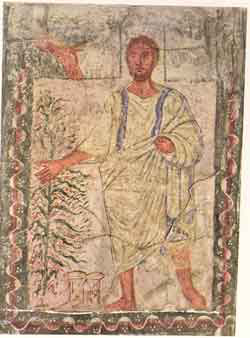Introduction
In this portion of our discussion of the women of the Book of Judges, we will deal with two nameless and victimized women – Jephthah’s daughter and the Levite’s concubine. These two stories epitomize one of the chief trajectories of the Book of Judges – the destruction of women by men. Both stories are found in the second half of the book, after we have already met a series of strong, assertive women. In some of those stories, men were the casualties – but here we will be dealing with the lives of women as tragedy.
Jephthah’s daughter
The Judge Jepthah (Judges 11 -12) is tainted from the outset – the son of a prostitute, he is disinherited by his brothers, gathers a gang of “low characters” and proceeds to live on the fringes of society as an outlaw. Because of his reputation as a “tough”, he is invited back to face the threat of an Ammonite attack. Stung by his initial rejection, he drives a hard bargain for his services. His ego inflated, he makes a rash vow:
If You deliver the Ammonites into my hand, then whatever comes out of the door of my house to meet me on my safe return from the Ammonites shall be the Lord’s and I shall offer it as a burnt offering.
As fate would have it, this promise backfires, when he returns victoriously and is greeted by his own daughter. Here begins our exposition of the story within the story, the fate of Jephthah’ daughter, one of the many unnamed women in the book of Judges.
35 “On seeing her, he rent his clothes and said, “Alas, daughter!
You have brought me low; you have become my troubler! For I
have uttered a vow (lit. opened my mouth) to the Lord and I
cannot retract it.” “Father, she said, you have uttered a vow to
the Lord; do to me as you have vowed, seeing that the Lord has
vindicated you against your enemies, the Ammonites. She
further said to her father, “Let this be done for me; let me be for
two months, and I will go with my companions and lament (lit
descend) upon the hills and there bewail my maidenhood.” “Go,”
he replied. He let her go for two months, and she and her
companions went and bewailed her maidenhood upon the hills.
After two months’ time, she returned to her father, and he did to
her as he had vowed.
Following this laconic account of the events connected with Jephthah’s daughter, we return to the main story, Jephthah’s career as Israel’s judge. He is a divisive force in Israel, and incites internecine carnage. Thus, the biblical text itself is covertly critiquing Jephthah and his leadership.
Midrash (Leviticus Rabba 37:4) is much more blatant in its criticism: Jephthah’s rash vow was invalid a priori. Furthermore, when it turned out to have dire consequences, it should have been annulled, but the egos of Jephthah and the “spiritual” leader, Phineas the High Priest, prevented this and Jephthah’s daughter paid the price .
The 13th century St. Louis Psalter begins its treatment of this story with the encounter between Jephthah and his daughter.
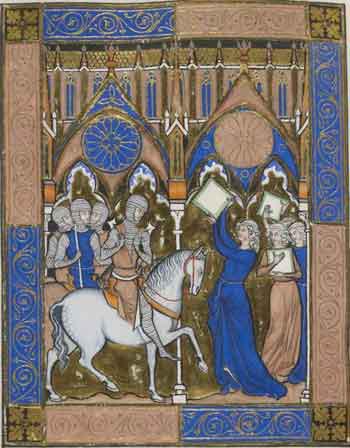
Tambourine in hand, the daughter greets her returning father, who tears his shirt in the agony of mourning. The two halves of the illumination express contrary moods: on the right, Jephthah’s daughter and her friends, on foot, joyously greet the warriors; on the left, as his steed tramples the joyous scene, Jephthah is distraught. The decorative orange and blue rectangles of the margins are reflected in reverse in the sunny rondel on the right and the gloomy one on the left.
Baroque artist Jacob Hogers places Jephthah’s daughter dead center festively robed and garlanded, extending her arms to her father, bearing the laurel wreath of victory and a large feather for his cap.
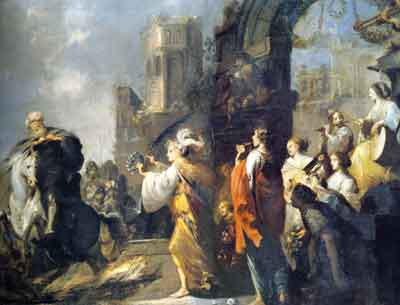
An ensemble accompanies her, moving through an imposing urban scene of arches and towers. The celebratory stream of musicians occupies two thirds of the painting. Their power is undermined by the oath of the single figure on the far left. The victorious Jephthah, tears his robe – he cannot face his daughter and looks askance; even his horse is horrified. These two, most likely, would like to flee the scene. Joy becomes sadness and power is crippled.
The two following 19th century portrayals of the same scene are so involved with the lusty women that they miss the point.
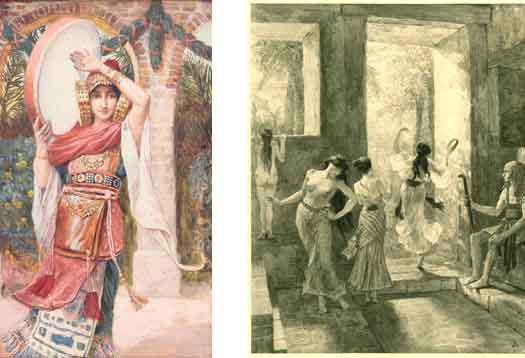
Tissot poses Jephthah’s daughter framed by an arch, undulating for a victory photo-opp, wearing a headdress of tambourines and playing a drum. There’s no hint of the coming fall. Laurens portrays a group of girls doing some last minute rehearsing before the curtain rises. Jephthah’s curvaceous daughter, seen from the back, dances through the doorway, while one entirely naked friend peeks over the windowsill and waves to the miniscule silhouette of the approaching troops. These might as well be scenes from the Song of Songs and not the moment before disaster.
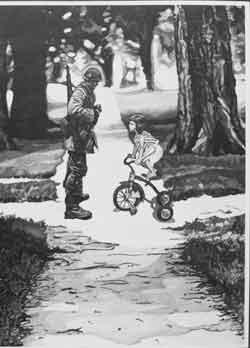
Dierdre Luzwick, 1979
As opposed to the luscious virgins of the 19th century, Dierdre Luzwick imagines Jephthah’s daughter as a 1st-grader on a tricycle and her father as a World War II vet. Her look is quizzical, “Who is this man?” So Luzwick retells the story as a modern Midrash – the plight of the returning soldier and his uncomprehending family. Long-term separation has sacrificed the family to political exigencies.
The most frequently treated scene in the story of Jephthah’s daughter is the fulfilling of Jephthah’s vow. Both literary and visual Midrash generally depict this fulfillment as the slaying of the daughter and this would appear to be the obvious intent of the biblical narrative.
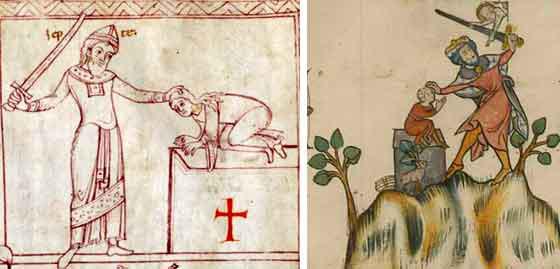
of the Holy Cross, 1296
1170
The two medieval illustrations above, show a parallel between the sacrifice of Jephthah’s daughter and the sacrifice of Isaac. Although created over 100 years apart, they demonstrate that the sacrifice of Jephthah's daughter was conceived similarly to the sacrifice of Isaac.
In most Midrashim , Isaac is portrayed as a willing martyr who urges his father to complete the act; since there is nothing in the biblical text of the Akedah to indicate such willingness, these Midrashim may actually derive from the explicit willingness of Jephthah’s daughter in the biblical account. A text from the Babylonian Talmud draws the parallel between Jephthah and Abraham, without comment. Pseudo-Philo likewise refers to the Sacrifice of Isaac in his retelling of the story of Jephthah’s daughter, holding up the midrashic Isaac as a model of piety. Thus there is a web of interconnections between the stories of Jephthah’s daughter and Isaac.
Christian theology goes a step further. The akedah as a prefiguration of the crucifixion is an ancient pillar of Christian thinking; occasionally, the sacrifice of Jepthah’s daughter is also likened to the crucifixion, as in the writings of Ephrem the Syriac. A 7th century visual representation of this parallel is found in the chapel of the Monastery of St. Catherine in Sinai. As a result, Jephthah becomes a positive figure in some Christian thinking, as opposed to the negative evaluation, overt in the Midrash and implied in the Bible.
For example, the 14th century Queen Mary’s Psalter is the only manuscript we found in which the kneeling Jephthah is seen making his vow to God. The two figures on the left are paralleled by two figures on the right. Here, Jephthah is no longer humble, but stands aggressively over his daughter to fulfill his vow. The kneeling figure now is the pious, submissive daughter, whose hair is pulled into position for the descending sword. “He did to her as he had vowed.” Jephthah is the model here of the pious king and his daughter is nothing more than the mute casualty.
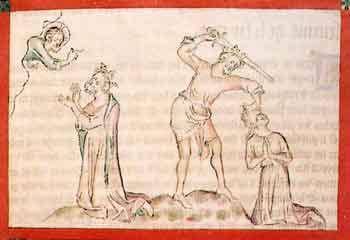
In medieval Jewish commentary, a radical and surprising new interpretation appears, in the commentary of R. Abraham ibn Ezra: lo and behold, the fool doesn’t do it. Ibn Ezra discovers an ambiguity in the text and reads Jephthah’s vow as,
Whatever comes out of my door will be the Lord’s
or I will offer it up
What other commentators understood as a single outcome in two phases should be read as two different options. This reading is based on the assumption of traditional scholarship that each biblical phrase has its own distinct meaning. The upshot of this reading is that if what comes out to greet Jephthah be appropriate for sacrifice, it will be sacrificed; if not, it will be otherwise dedicated to God. Since, as it turns out, Jephthah’s own daughter greets him, she obviously (!) cannot be sacrificed. Therefore, Ibn Ezra concludes, she was consecrated to a life of meditation and prayer. The great Jewish commentators Radak, Ralbag, Abravanel and Malbim accepted this reading, while the Ramban rejected it out of hand. Only Nicholas of Lyra, among Christian commentators, accepted the view that she was not sacrificed, apparently following Radak; as it turns out, Nicholas was a Jewish convert to Christianity!
Church history contextualizes Ibn Ezra’s novel interpretation. Between the years 1000 and 1300, the number of convents in Europe increased tenfold. Since no such institution existed within Judaism, this increase may have been the model for the new interpretation of Jephthah’s vow.
We have only a single work of art that illustrates this surprising new interpretation:
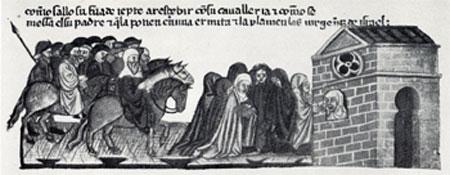
Alba Bible, 1430
In the 15th century Alba Bible, a joint Jewish-Christian commentary, the story is presented as three scenes. The returning cavalry headed by Jephthah on the left fills more than a third of the picture. At center, Jephthah’s daughter herself is the single white-clad figure, attended by black-robed “virgins of Israel” mourning for her. On the right, Jephthah’s daughter appears again; this time she is framed by the window of her new residence– apparently a convent, identified by the its rose window. The doorway of the building is a strange dark silhouette in the shape of the one who will never exit. Thus it appears that R. Moshe Arragel, the advisor for this translation-commentary, adopted Ibn Ezra’s reading for the Alba Bible.
Nevertheless, most artists continued to portray the scene as human sacrifice. In the Baroque sculpture of Massimilano Soldani, a cruel hand seizes the helpless victim, vaguely protected by the shadow of the virgins of Israel.
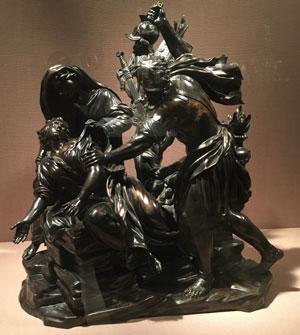
Jephthah’ daughter does not look at her father, but heavenward. Her left hand seeks in vain for support, while her right hand openly asks: why? It is fortuitous that Jephthah’s sword, originally at the center of the piece in his raised hand, has been lost at some point. Only his armor and other battle gear, retired to a barren tree, remain.
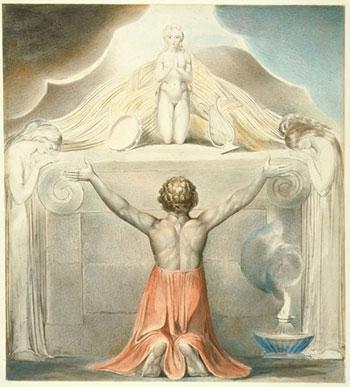
Romantic visionary William Blake places a diminutive, elf-like Jephthah’s daughter kneeling in prayer on a massive ionic altar, musical instruments beside her and reeds for the sacrifice behind her. Below her kneels her father, his arms outstretched in prayer; beside him smoke rises from the sacrificial fire. At either side of the altar stand lamenting companions and above, the sky is divided into darker and lighter halves. The entire picture is composed of triangles: blue and white clouds above, the sacrificial reeds, the prayerful hands of the daughter and the father, etc. These triangles could hint at hidden sexual interest. However, in a deeper sense the triangles enclose the tragic relationship of the father, the daughter and God.
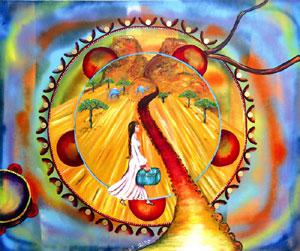
Yafa Nevo, 2010
Finally, in contemporary Israeli artist Yafa Nevo’s painting, Jephthah’s daughter carries her overnight bag to the place of her distant exile. The picture is framed by the tambourine from her original musical encounter welcoming her father. A landscape of fruit, whole and cut, carries the eye to a strange vanishing point. The picture is a lament for the wasted seed, the lost potential, of this heroic but nameless woman.
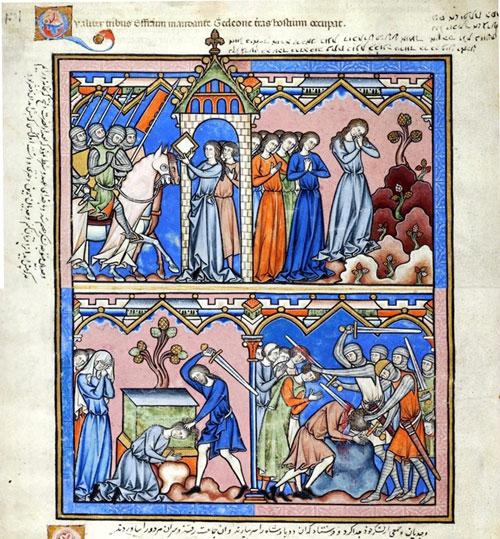
To summarize, we come back to a seemingly literal, normative reading, as represented in the 13th century Morgan Bible. On a single page, the artist deals with the three major scenes of the story of Jephthah’s daughter and then oddly moves on to another tale from Judges. At top left, portrays Jephthah’s daughter greeting her father in a manner similar to the contemporary rendition of the St. Louis Psalter; here his hands are clasped in grief, prior to tearing his cloak. The panel at top right illustrates the mourning of Jephthah’s daughter and her companions during the moratorium granted her prior to her demise. Our questions arise from the lower panel, where surprisingly the altar is unoccupied, although identified by a cruciform tree. Jephthah’s daughter kneels before the altar, her prayerful hands resting on a prominent rock. Her father pulls her hair, to expose her neck, raising his sword ominously, while her companions look on (prefiguring the women of Jesus’ entourage at the crucifixion). The mystery and surprise unfold in the lower right panel, out of place and seemingly unrelated; this is the scene from Judges 9 in which Abimelech slaughters his 70 brothers “on one stone”. Why has this scene been placed here? The answer is formal and theological: Jephthah’s daughter cannot legitimately be sacrificed on the altar, so she is executed on a stone, just as the 70 brothers are. A strong diagonal of raised swords also unites both panels, thus making the statement that the death of Jephthah’s daughter was not a pious sacrifice prefiguring the crucifixion, but a wanton murder. Thus what seemed to be a naïve normative reading of the story turns out to be subversive.
The Levite’s Concubine
The Book of Judges ends with a horror story. From the beginning of the book, violence is the default behavior of the people of Israel, in line with the familiar phrase:
There was no king in those days
and everyone did whatever they pleased.
Nonetheless, there’s no hint at the depth of depravity that will unfold in this final story.
The main character of the story seems to be the concubine of a Levite from the hill country of Ephraim. But she turns out be a mere pawn. Like all the other characters in this tale, she is unnamed; but unlike the others (including entirely minor figures), she is not given a single word of speech. At the outset of the story, the concubine leaves her husband, for reason not made clear, and returns to her father’s home in Bethlehem of Judah. Four months later (!) the Levite follows to reclaim her; day after day, his hospitable father-in-law delays their departure. Having finally left as the light fades, they decide against staying in nearby Jerusalem, fearing this city of foreigners. They arrive at the Benjaminite city of Gibeah in the dark, unwelcomed until an elderly Ephraimite offers them his hospitality. Local perverts surround his house and demand to have their way with the Levite. Instead, the concubine (!) is pushed out the door. In the morning, the Levite, unmoved to find her body on the doorstep, loads her on to a donkey. heads home, dismembers the corpse and sends the parts to the 12 tribes. Their fury is aroused and a civil war that ensues, in which Benjamin is decimated. For the sake of tribal survival, the remaining Benjaminites are given women procured by abduction.
In an early rabbinic discussion, the question of censorship is raised. It’s so horrible, maybe we should just not talk about it, remove it from the curriculum. But this option is rejected; the story, like other embarrassing episodes (Lot and his daughters, the Golden Calf, Judah and Tamar) should be read and processed.
Another (disappointing) midrashic treatment of our story, juxtaposes it with the story of Micah’s idol (Judges 17). The rabbis conclude that Israel was punished for being more concerned about the concubine than they were about idolatry. But in fact, the implication of this “learning” is that the unnamed woman becomes even more marginalized than in the Bible.
The 13th century Morgan Bible, containing hundreds of images from the Hebrew Bible, devotes fully eleven panels to the grotesque concluding episode of Judges. The visual narrative opens with the hospitality offered at Gibeah and continues in the dining room.

Morgan Picture Bible, 1244 - 54
Action proceeds as the the scene pictures the terrified concubine being delivered into the hands of the armed gang.
The artist then renders:
22 While they were enjoying themselves, the men of the town, a
depraved lot, had gathered about the house and were pounding
on the door. They called to the aged owner of the house, “Bring
out the man who has come into your house, so that we can be
intimate with him.” 23The owner of the house went out and said
to them, “Please, my friends, do not commit such a wrong. Since
this man has entered my house, do not perpetrate this outrage.
24Look, here is my virgin daughter, and his concubine. Let me
bring them out to you. Have your pleasure of them, do what you
like with them; but don’t do that outrageous thing to this man.”
25But the men would not listen to him, so the man seized his
concubine and pushed her out to them. They raped her and
abused her all night long until morning; and they let her go when
dawn broke.
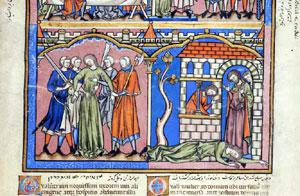
The artist mercifully spares us the details, ending this scene with the body of the concubine on the doorstep.
Twelve figures crowd the next double panel. The concubine, flung prone and faceless on the donkey, shocks the viewers. Pale and dismembered on an altar-like table, she is an ironic contrast to the lively animal in the adjoining panel. The use of the word ma’achelet (butchering knife) is a transparent allusion to the sacrifice of Isaac and the Levite’s posture is reminiscent, once again, of how Abraham is often portrayed. She is not even a sacrifice, but merely a call to arms, a symptom of Israel’s decay. Her dissected body is multiplied by 12, finally giving her at least a fleeting, symbolic role
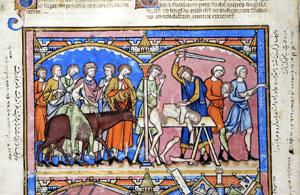
There is no repentance and no forgiveness. The extensive coverage of this awful story in the Morgan Bible is not unlike current mass media’s fascination with the ghoulish.
Four hundred years later, two Dutch artists chose to interpret relationships, rather than the grotesque.
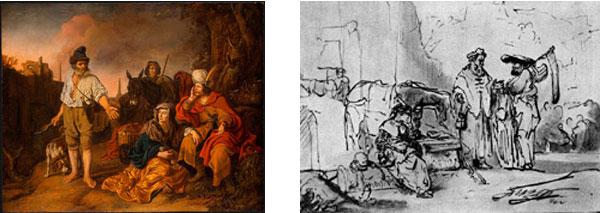
G. van der Eekhout, Rembrandt,
The Levite at Gibeah, c. 1650 The Man of Gibeah, c. 1645
Eekhout and Rembrandt both portray the night scene in which the Levite and company are offered hospitality in Gibeah. The text is silent with regard to the concubine’s relationship with her husband. She leaves him; we don’t know why. It takes him four months to go after her; we don’t know why. Their reunion in the father’s house emphasizes only the gustatory delights. The two pictures above read this relationship very differently. Eekhout places the couple in affectionate proximity. Although her hand rests on his knee, his interest is focused on the potential host. In the Rembrandt scene, she sits separate among the suitcases, while the two men are in close conversation. Intimation of the coming disaster is missing from both pictures. The artists have chosen an isolated prelude.
In contrast, in Dore’s illustrated Bible of 1860, the focus is on the outrage and its inevitable consequences.
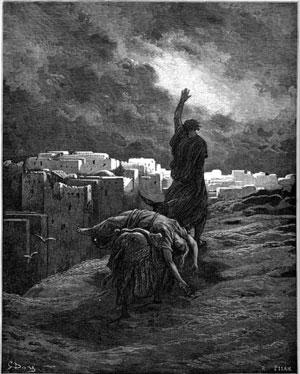
At the center of the picture, the Levite, silhouetted against the white town, rises vertically, extending his arm in a cry of fury. Isolated even in death, the concubine lies broken horizontally across the back of their donkey. She was nothing in life, and now she is merely the tool for his revenge.
The power of Janet Shafner’s Concubine of Gibeah is controlled within its geometric patterns. She writes that one painting evolved into three. Body parts and wolves dominate throughout. The wolf is Benjamin’s totem as described in Genesis 49, known as Jacob’s Blessings. But Shafner uses this biblical text as an ominous portent of the dehumanization of the people of Benjamin, in particular, and of Israel in general.
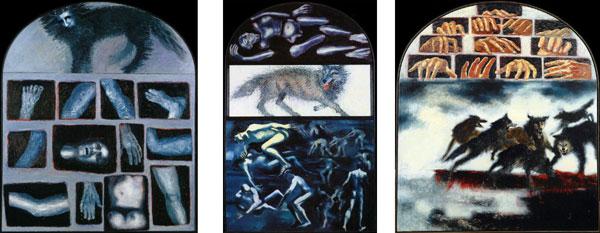
On further examination, the artist numbered the paintings sequentially, leading us to view them as a triptych. This unified view reveals animal savagery intensifying diagonally, from top to bottom and left to right. A human-faced animal becomes a bloody tongued wolf with a repulsive coat. Finally, it multiplies into a vicious pack. Throughout, we barely see the concubine as a person, but only as body parts: 12 in panel 1, 12 in the upper part of panel 2, and 12 hands in panel 3. The central panel pictures the attacked and the attackers; a riot of bodies. The hands of panel 3, the only flesh-color in the triptych, are the victim, grabbing, scratching, pleading, surrendering. The art of the 21st century in its interpretive expressionism is a powerful contrast to the stylistic and realistic narrativism of the earlier works. Without Shafner, our treatment of this story would be dispassionate; her work makes ones blood boil.
We’ve dealt with four of the major extended units of the book of Judges: in two, women destroy men and in two. men destroy women. Plautus wrote in the 3rd century BCE: “Homo homini lupus”, man is a wolf to his fellow. In the book of Judges it could also read: man is a wolf with women.
For additional images on this subject see TALI Visual Midrash



